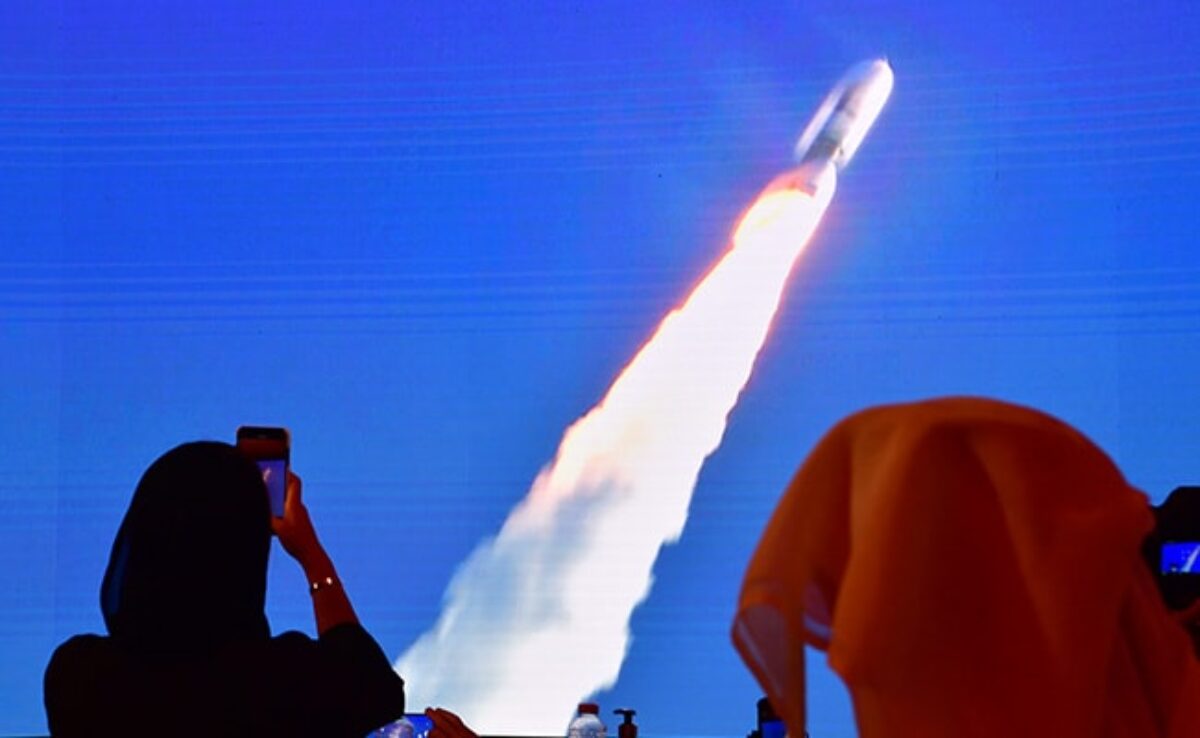
Tokyo- The first Arab space mission to Mars, an unmanned probe dubbed “Hope”, blasted off from Japan on Monday, in a bid to reveal more about the atmosphere of the Red Planet.
The Japanese rocket carrying the probe developed by the United Arab Emirates (UAE) lifted off from the Tanegashima Space Centre in southern Japan right on schedule at 6:58 am local time (2158 GMT Sunday).
The launch of the probe, known as “Al-Amal” in Arabic, had twice been delayed because of bad weather, but the Monday liftoff appeared smooth and successful.
Almost exactly one hour later, a live feed showed people applauding in the Japanese control room as the probe successfully detached.
“The launch vehicle trajectory was executed as planned and separation of the Hope spacecraft was confirmed,” rocket manufacturer Mitsubishi Heavy Industries said.
In Dubai, the launch was met with rapturous excitement, with the Burj Khalifa — the world’s tallest skyscraper — lit up hours before liftoff with a symbolic 10-second countdown in anticipation.
“This mission is an important milestone for the UAE and the region,” said Yousuf Hamad AlShaibani, director of the UAE’s Mohammed bin Rashid Space Centre, at a post-launch press conference in Japan.
“It has already inspired millions of youth regionally to dream big and work hard to achieve what seems to be impossible,” he said.
Human Mars settlement?
The Emirati project is one of three racing to Mars, including Tianwen-1 from China and Mars 2020 from the United States, taking advantage of a period when the Earth and Mars are nearest.
In October, Mars will be a comparatively close 38.6 million miles (62.07 million kilometres) from Earth, according to NASA.
“Hope” is expected to enter Mars orbit by February 2021, marking the 50th anniversary of the unification of the UAE, an alliance of seven emirates.
Unlike the two other Mars ventures scheduled for this year, it will not land on the Red Planet, but instead orbit it for a whole Martian year, or 687 days.
While the objective of the UAE’s mission is to provide a comprehensive image of the weather dynamics, the probe is a foundation for a much bigger goal — building a human settlement on Mars within the next 100 years.
Dubai has hired architects to imagine what a Martian city might look like and build it in its desert as “Science City”, at a cost of around $135 million dollars.
The UAE also wants the project to serve as a source of inspiration for Arab youth, in a region too often wracked by sectarian conflicts and economic crises.
‘Pride, hope, peace’
On Twitter, the UAE’s government declared the probe launch a “message of pride, hope and peace to the Arab region, in which we renew the golden age of Arab and Islamic discoveries.”
Several dozen probes — most of them American — have set off for the Red Planet since the 1960s. Many never made it that far, or failed to land.
The drive to explore Mars flagged until the confirmation less than 10 years ago that water once flowed on its surface.
Omran Sharaf, the mission’s project manager, has said the Hope probe will offer a special perspective on the planet.
“What is unique about this mission is that for the first time the scientific community around the world will have an holistic view of the Martian atmosphere at different times of the day at different seasons,” Sharaf told a pre-launch briefing.
Hope is expected to begin transmitting information back to Earth in September 2021, with its data available for scientists around the world to study.
The UAE already has nine functioning satellites in Earth orbit, with plans to launch another eight in coming years. And in September, it sent the first Emirati into space on a mission to the International Space Station.
Follow this link to join our WhatsApp group: Join Now
Be Part of Quality Journalism |
Quality journalism takes a lot of time, money and hard work to produce and despite all the hardships we still do it. Our reporters and editors are working overtime in Kashmir and beyond to cover what you care about, break big stories, and expose injustices that can change lives. Today more people are reading Kashmir Observer than ever, but only a handful are paying while advertising revenues are falling fast. |
| ACT NOW |
| MONTHLY | Rs 100 | |
| YEARLY | Rs 1000 | |
| LIFETIME | Rs 10000 | |










